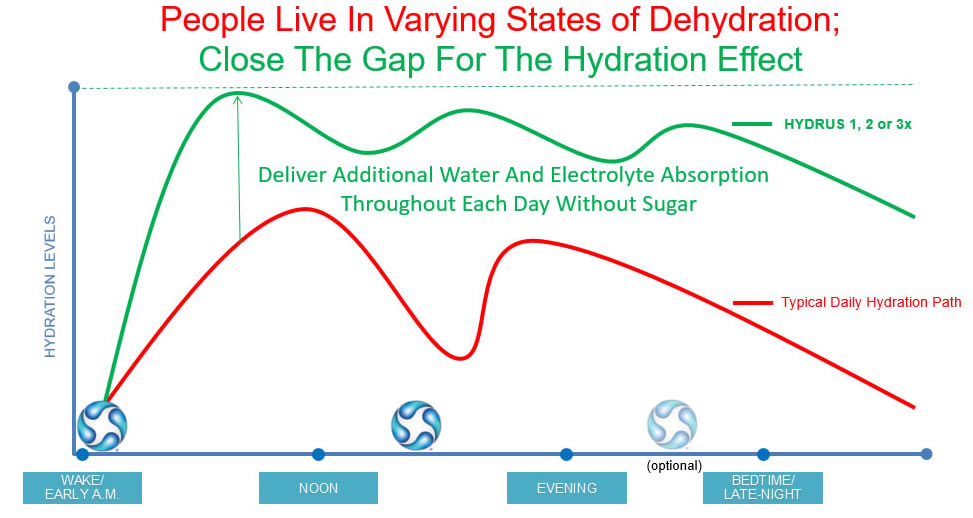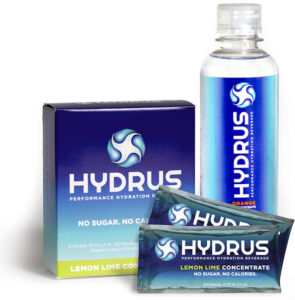What is The Dehydration Gap?
The dehydration gap – what is it? There is a gap in hydration levels that, when filled, helps people to feel and perform at their best – maybe even beyond expectations. Nearly everyone can benefit by recognizing and being attentive to proper hydration, but a gap can occur throughout the day while your body takes in and loses essential fluids. Surprisingly, people live and function with various degrees of dehydration each day. Often, the situation is affected or made worse by medical conditions, medications, environment or high activity levels that can make filling this gap even more challenging. Even though it is a daily necessity to stay properly hydrated, the facts point to a common and consistent failure by most people to do it well.
Here are just two examples:
- Over 50% of people arrive at work and depart from work measurably dehydrated each day; and
- Almost 80% of surveyed workers believe they do not drink enough water to meet their health needs.
It is clear that most people can benefit from raising hydration even by a small amount throughout the day, but why, with waters and beverages so readily available, do so many people fall so short when it comes to hydration? The answer has four parts:
- Understand the role hydration plays in wellness, well-being and overall health;
- Recognize the many unattributed symptoms where a root cause is likely dehydration;
- Learn why water and conventional beverages often fall short; and
- Discover a new way to fill the gap, whenever water alone is not enough
Build Your Foundation For Daily Wellness
The foundation of daily wellness is hydration. It supports the other inputs – diet & nutrition, exercise, sleep and mindfulness – that go into a healthy lifestyle, which in turn drives overall health & well-being outcomes. Increasingly, the last few percentage points of hydration are being recognized for their contribution to greater health & physical well-being outcomes and ultimately greater overall well-being as shown below.

The Dehydration Gap – What To Look For
The dehydration gap prevails in part because people regularly fail to recognize they are dehydrated at a level that affects their daily life. Routinely, people attribute symptoms they suffer to something other than dehydration. For example:
- Most people regularly mistake thirst for either hunger or lack of energy that they compensate for by consuming food or drinks with sugar or stimulants, when hydrating more effectively may deliver a more healthy and direct solution.
- Huge populations, including medical professionals, fail to recognize dryness conditions, such as dry eyes, dry mouth, dry nose, dry skin and vaginal dryness may have dehydration as a root cause. They often treat these conditions by applying topical temporary solutions, such as eye drops, mouth washes, nose sprays, lotions and ointments, rather than beginning by hydrating more effectively.
- Many more symptoms, such as anxiety, lack of mental clarity, brain fog, moodiness, tiredness, headaches, poor sleep, muscle & joint soreness, cramps, spasms or constipation, may be rooted in dehydration. Their treatments may include many different possibilities, including over medication, rather than simply more effectively hydrating.
People that persistently experience these symptoms above may require a more extensive time frame to reverse chronic dehydration.
How To Manage The Dehydration Gap
Hydration occurs when water flows into cells with a higher concentration of electrolytes via osmosis, which is the reason electrolytes are equally as important as water to hydrate effectively. Theoretically, people could close their dehydration gap merely by modifying behavior to consume more water and electrolytes at the right time and in the right quantities through diet and drink, but many people don’t, either because they do not perceive the need or they do not have an easy or readily available solution. Fortunately, hydration has a long history of advancement, both in terms of understanding and specialized solutions.
During the last 150 years, scientists, medical professionals and marketers developed hydration products for patient and consumer applications to assist them in their quest to hydrate more effectively. These include intravenous (IV) therapy for critical care patients, oral rehydration solution (ORS) for severe illness in outpatient care, pediatric hydration drinks for mild illness, (e.g., diarrhea and vomiting), in home care and sports drinks for heavy sweating during high activity. Unfortunately, none of these solutions are designed for healthy daily use. IVs are for direct injection under medical supervision. The rest contain sugar to assist electrolyte absorption, but they either contain too many electrolytes or too much sugar or both for daily use.
In the last 20 years, waters and fitness drinks that are sugar-free and contain electrolytes became widely available for daily use. These sugar-free electrolyte drinks are close to being a viable solution, but they lack being functional, they don’t contain any science that assists electrolyte absorption. As a result, these drinks have made no noticeable dent in the dehydration gap.
Well-being Hydration Beverages
Whenever water and diet are not enough, Well-being Hydration beverages are specifically designed to assist water and electrolyte absorption without sugar for use daily and throughout the day, anytime it is necessary to hydrate effectively. They contain electrolyte payloads to replace losses from daily respiration, perspiration and body functions. For a healthy lifestyle, few things are as critical as filling the gap in dehydration by helping people absorb just a little more water and electrolytes a few times more each day.

Why Well-being Hydration Matters
Well-being Hydration beverages empower Individuals, Family Members, Friends and Colleagues to self-treat dehydration as the root cause of the many symptoms they endure each day; often people discover health benefits, more energy and greater acuity (visual, mental and physical) and less dependence on sugar and stimulants.
Young and Aging people have less resources to manage dehydration and are particularly vulnerable, especially when they are ill or have medical conditions.
Patients are sensitive to dehydration, especially the 60% of the population that have chronic medical conditions, and the almost 50% that regularly take medications.
In Organizations, Well-being Hydration can close the dehydration gap for employees, from those that perspire due to activity or environment to those that develop dry eyes and mental fatigue due to hours staring at screens. Very few things improve wellness and productivity more than raising hydration ½ percent or more throughout the day for both blue- and white-collar workers. See Two Unconventional Points of View That Can Unleash Employee Productivity for more information about productivity.
See our article on Hydration Beverages for a summary and more detailed information about hydration beverage categories, including IV therapy, pediatric illness hydration drinks, sports drinks, waters & fitness drinks and Well-being Hydration beverages. In the meantime, please direct questions to info@hydrusmail.com.
Enjoy Your Health Each Day
Unlike other hydration products, Hydrus contains Nanosomes™ or tiny nano-scale hollow sphere-shaped molecules made of phospholipids that encapsulate electrolytes and water. The phospholipids are similar to those naturally found in your cells’ membranes.
Compared to other hydration drinks, studies show that the science in Hydrus delivers about 50% greater water and electrolyte absorption than traditional sugar-electrolyte drinks.
Hydrus will help to ensure that you are able to enjoy your health every day!
